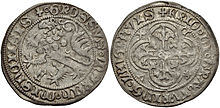Meissen groschen

obverse: Meißner lion rising to the left with a single tail,
Latin inscription: GROSSUS MARCHIONNIS MISNENISIS (Groschen of the Meissen region) Reverse
: Lily cross with quatrefoil,
Latin inscription: Abbreviated title of the mint owner : DEI GRATIA THURINGIAE LANDGRAE LANDGRAE God's grace Landgrave of Thuringia)
The Meißner Groschen or Breite Groschen was a Meissen - Saxon silver coin of the 14th and 15th centuries and the regional groschen currency of the Margraviate of Meißen in the late Middle Ages . It was introduced by Margrave Friedrich II of Meissen in 1338/39 and minted according to the model of the Prague groschen .
distribution
The Margraves of Meissen had large silver deposits in the Ore Mountains . For the first hundred years they let the Meissner groschen only beat in Freiberg . The Freiberg mint processed a total of 301,298 marks (around 70.5 tons) of fine silver from 1353 to 1485 . Since a lot of silver could be minted, the Meißner Groschen was not only used in the margraviate of Meißen, but also beyond the limits of its actual scope. Like the Prague groschen, it was often imitated and counter-stamped .
Embossed
The Meissen Groschen was minted in the Freiberg and Zwickau mints . On the main page (obverse) the embossing until 1405 shows the Meissen lion rising to the left with a single tail and the Latin inscription: GROSSUS MARCHIONNIS MISNENISIS (Groschen der Mark Meissen). A lily cross with quatrefoil and the abbreviated title of the mint owner as a Latin inscription : DEI GRATIA THURINGIAE LANDGRAVI (By God's grace, Landgrave of Thuringia) were stamped on the reverse . From 1457 onwards, dates were often set interrupted (in the series 1465–1469 and 1490–1499).
Types of the Meissen Groschen
Thousands of types of the Meissen Groschen, including the stamp variants, were minted:
- Princely penny
- Helmet money
- Horn egg
- Jew's head groschen
- Cross egg
- Lion penny
- Shield egg
- Sword egg
Coin deterioration
The monetary standard of the Meissnian-Saxon silver groschen decreased over time (see Gresham-Copernican law ). In 1338 a fine Prague coin mark (approx. 253.14 g) was minted 14 2/9 soldered silver (= 888/1000 fine) 66 2/3 groschen with a rough weight of 3.797 g and a fine weight of 3.375 g. By 1360, the fineness was reduced so much that 70 groschen - now with a fine weight of 2.788 g - were minted from the same amount of silver. In 1432 525 groschen were minted from a fine Prague mint mark; the individual coin weighed only 0.48 g of silver.
Currency adjustment to the Rhenish guilder
The currency adjustment of the Meissen groschen to the Rhenish guilder as the basis for the regional groschen currency of the margraviate of Meißen took place from 1368 to 1369. During this time, groschen of the wide groschen type were minted in the state main mint Freiberg and the Zwickau mint . A fixed exchange rate between Meissner groschen and Rhenish guilder has been established since the middle of the 15th century . Initially minted in a ratio of 1/20 or 1/21 to the Rhenish guilder, this groschen, known as " Oberwähr ", had to be accepted for all payments in the Margraviate of Meißen. Later, the Meissner Groschen was minted in the ratio 1/26 to the gold gulden and referred to as " Beiwähr ".
literature
- G. Krug: The Meissnisch-Saxon Groschen 1338 to 1500. Publications of the Museum for Prehistory Dresden 13, Berlin 1974.
Web links
Individual evidence
- ↑ a b c d e f g h i j k Heinz Fengler, Gerhard Gierow, Willy Unger: Transpress Lexikon Numismatics. Berlin 1976, p. 281.
- ^ A b c d Paul Arnold: "Guide through the permanent exhibition of the coin cabinet." 2nd expanded and improved edition 1978, Staatliche Kunstsammlungen Dresden (Ed.), P. 14f.
- ↑ a b Exhibition guide : 7 centuries of mining and coinage in Saxony and Thuringia 1168–1872. Joint exhibition of the Staatl. Museum f. Mineralogy and Geology and the Münzkabinett of the Staatl. Kunstsammlungen Dresden In: View into the museum. Issue 26, 1981.
- ↑ Gerhard Krug: Die Meißnisch Saxon Groschen 1338-1500 , Berlin 1974, p. 114